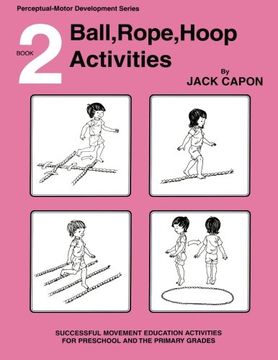Share
Ball, Rope, Hoop Activities: Book 2: Volume 2 (Perceptual-Motor Development Series)
Jack Capon
(Author)
·
Createspace Independent Publishing Platform
· Paperback
Ball, Rope, Hoop Activities: Book 2: Volume 2 (Perceptual-Motor Development Series) - Capon, Jack
Choose the list to add your product or create one New List
✓ Product added successfully to the Wishlist.
Go to My Wishlists
Origin: U.S.A.
(Import costs included in the price)
It will be shipped from our warehouse between
Friday, July 05 and
Wednesday, July 17.
You will receive it anywhere in United Kingdom between 1 and 3 business days after shipment.
Synopsis "Ball, Rope, Hoop Activities: Book 2: Volume 2 (Perceptual-Motor Development Series)"
This is the Second in a series of Five motor development activity books in the Perceptual-Motor Development Series covering preschool and the primary grades. This book is divided into 3 Parts: Part 1--Ball Activities; Part 2--Rope Activities; and Part 3--Hoop Activities. The book consists of 53 pages and all the activities are sequenced according to difficulty. PART 1 introduces the students to Ball Activities which utilizes a ball which is a marvelous piece of equipment for children. It is the most commonly used equipment in physical education programs as well as in natural play experiences. Its versatility allows it to be manipulated in so many ways. It can be bounced, thrown, rolled, kicked, butted and socked. From infancy, children are eager to be challenged by that round elusive object--the ball. It promises excellent opportunities for developing hand-eye coordination and visual tracking skills necessary for general academic achievement. The ability to handle and control a ball is an important skill for all children. Children who do not have the opportunity to develop these competencies tend to perform poorly and as a result avoid participating in games and sport activities. By implementing a comprehensive program arranged by skill levels that progress from simple to difficult based on sound mechanical principles, the children have more opportunity to be successful. As the child matures, games and sport activities become increasingly popular and an integral part of regular play and recreation. Th child' relationship with his peers and his basic self-image can be strongly influenced by his ability to successfully handle a ball. Basic ball skills insure the proper application of force, accuracy and balance. Children can participate in more advanced and demanding games if they first master basic skills. PART 2 introduces the students to Rope Activities which, as traditionally used in the school physical education programs, serve a rather limited purpose. Their use is confined primarily to rope turning and jumping tasks. Using the rope in movement exploration and perceptual-motor programs affords children the opportunity to explore the physical properties of the rope. The tactile sensation of the rope enhances their language development. They are encouraged to feel the rope, to describe it and to discover what can be done with it. It provides maximum enjoyment and many opportunities for creative expression. Rope jumping is rhythmic and it takes courage and timing for success. Boys are often reluctant to participate. They need to be assured that boxers, football players, and tennis players use the rope to strengthen leg and wrist muscles. It helps increase coordination and flexibility of both the mind and the body. Less able students can achieve success and personal satisfaction by using the rope on the ground as an obstacle. As confidence and skill increase, the children can progress to the more difficult task of jump roping. PART 3 introduces the students to Hoop Activities because the hoop is a highly adaptable teaching tool. It can be manipulated in a variety of challenging ways and has appeal to children of all ages. It is durable, inexpensive and safe. These characteristics make it one of the most popular pieces of equipment used in movement exploration and perceptual-motor programs. Hoops can be purchased commercially or constructed from rolls of plastic pipes or tubes found in many hardware stores. Homemade hoops are more economical and will generally outwear the commercial hoops. The commercial hoops do have the advantage of being available in bright colors. This adds a pleasing visual quality to the movement environment. Enough hoops should be available so that each member of the class has his own hoop. Throughout the tasks, the total involvement of each child is necessary for success.

